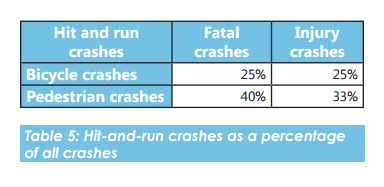As Chicago develops an action plan to eliminate traffic crashes resulting in fatalities and serious injuries, one of the questions we need to tackle is why so many people involved in crashes flee the scene.
Relative to peer cities, hit and run crashes occur more frequently in Chicago and they’re more likely to involve people walking and people biking.
The city’s 2011 pedestrian crash analysis report showed that over five years hit and run crashes accounted for 40 percent of fatal crashes in Chicago versus 20 percent nationally. A similar analysis of bicycle crashes in 2012 found 25 percent of bike crashes were hit and runs.
These trends have continued in recent years based upon preliminary data reported by John Greenfield in the Chicago Reader.
While the frequency of hit and run crashes is well-known, strategies to reduce and eliminate them are harder to identify. Here are a couple reforms that other cities have pushed to address the problem:
- Stricter Penalties: The penalties for Illinois drivers caught fleeing the scene of a crash vary depending upon the severity of the crash and if the driver returns. In some cases, drivers may be incentivized to flee if they are intoxicated or wanted for another crime that would result in a stiffer penalty. Chicago should work with the state’s attorney to evaluate and reform hit and run penalties and procedures. After only one percent of drivers involved in hit and run crashes were prosecuted in New York City, our peer advocates at Transportation Alternatives published a report calling for stiffer penalties and changes in how hit and runs are reported and prosecuted. Stricter penalties have shown to be most effective as a deterrent when they’re paired with public awareness campaigns.
- Better Communication: Law enforcement knows the first few hours after a crash is the most critical period to identify drivers who flee the scene. Chicago should develop an alert system so people are notified soon after a driver flees the scene, and consider a public awareness campaign encouraging crash witnesses to report incidents to police. In 2013, Denver established a notification system that alerts all patrol cars, cabdrivers, news outlets, trucks drivers and pedicab operators in the event of a hit and run crash. Messages are also displayed on traffic reader boards and on Crime Stoppers‘ Twitter and Facebook accounts. The “Medina Alert” system, named after a 21-year-old hit and run crash victim, became Colorado state law in 2014.
Beyond these policy changes, progress on Vision Zero goals to improve infrastructure, enforcement and education would reduce all traffic crashes, including hit and runs. One of the benefits of the Vision Zero approach is it allows cities to look at traffic safety comprehensively and attack a range of problems with complementary solutions.
Join the fight for safer streets by signing our Vision Zero Call to Action.
Learn more about Vision Zero – including our policy recommendations on commercial vechicles and speeding – on our Vision Zero campaign page.
Graphic Credit: CDOT Bike Crash Report (2012)

